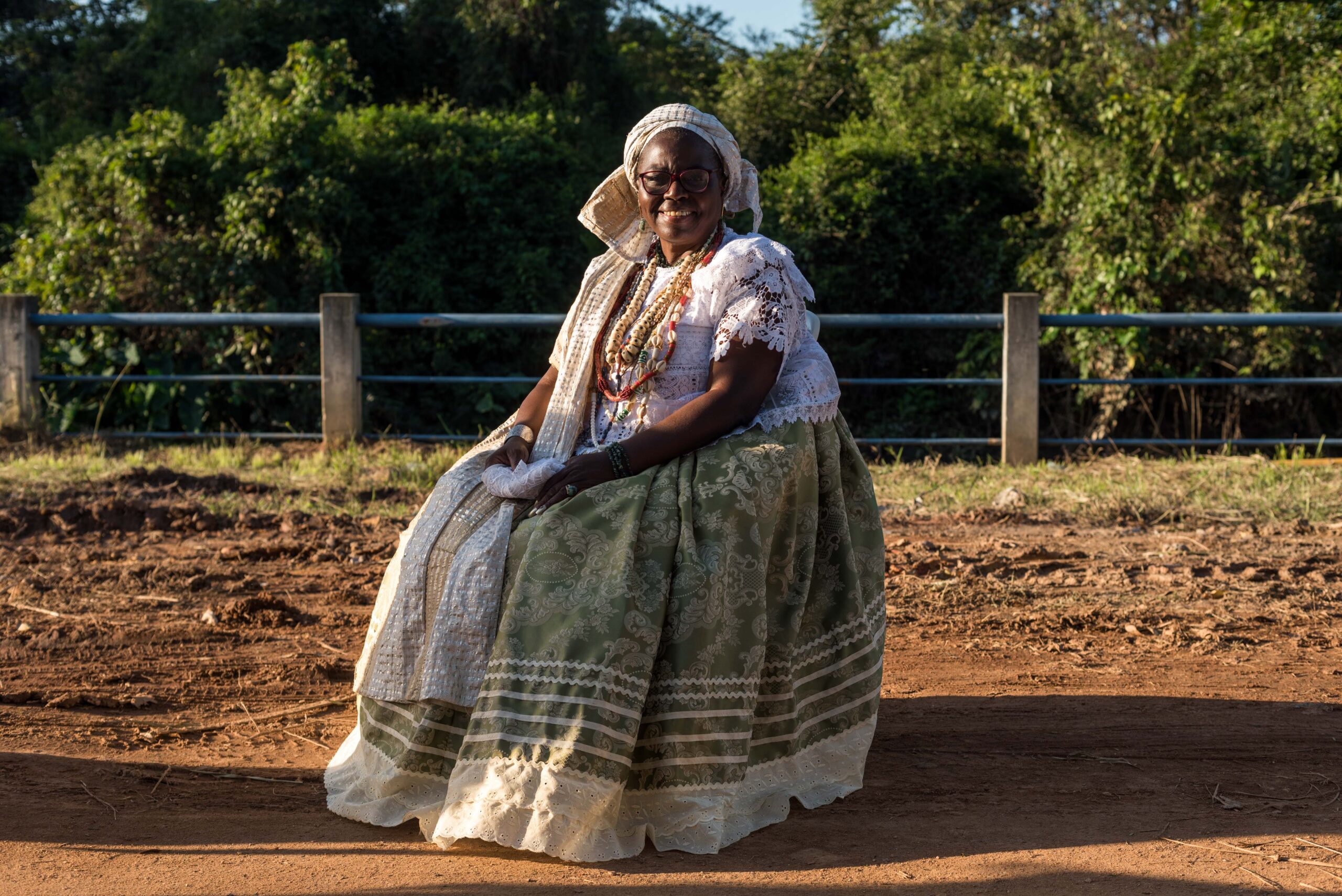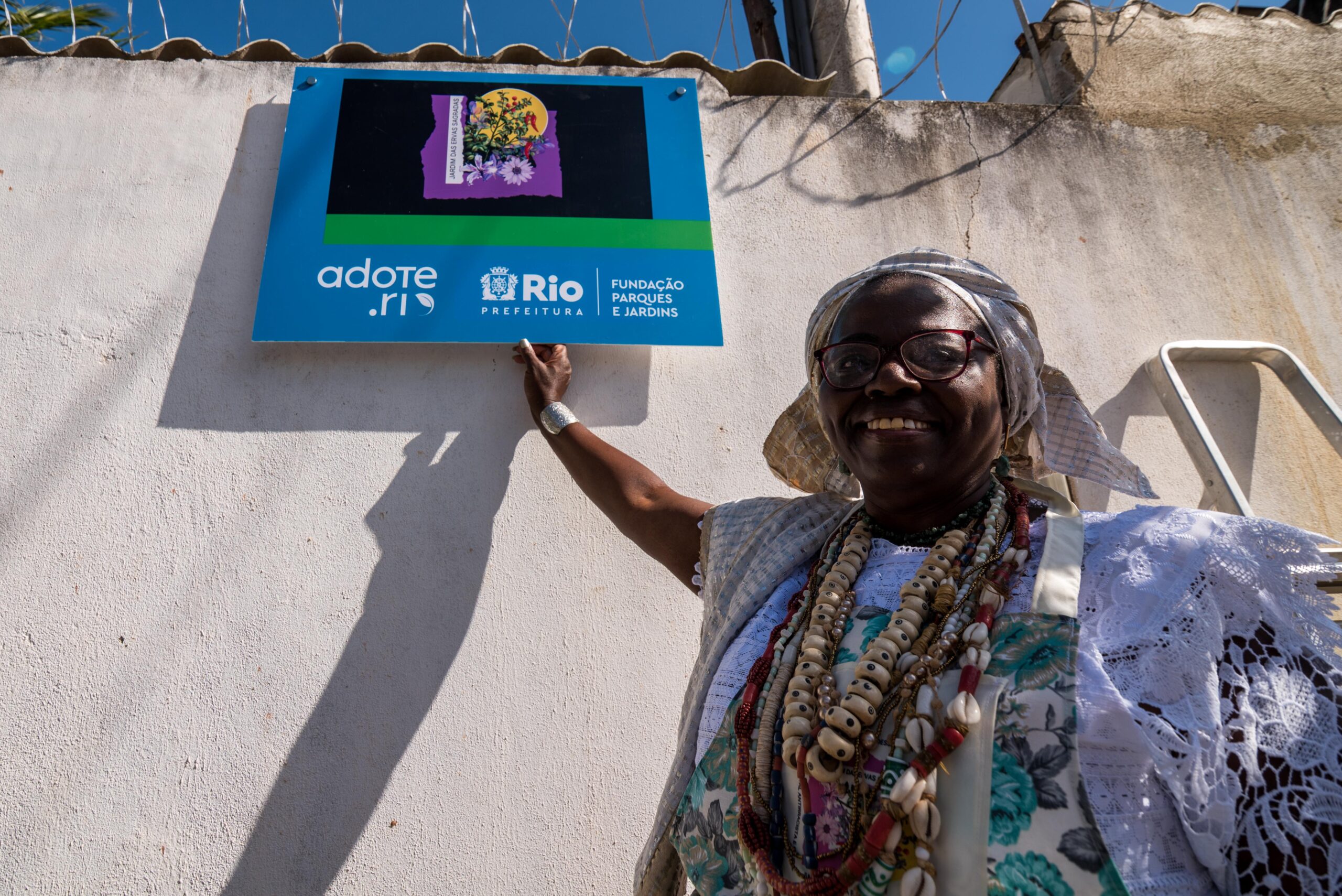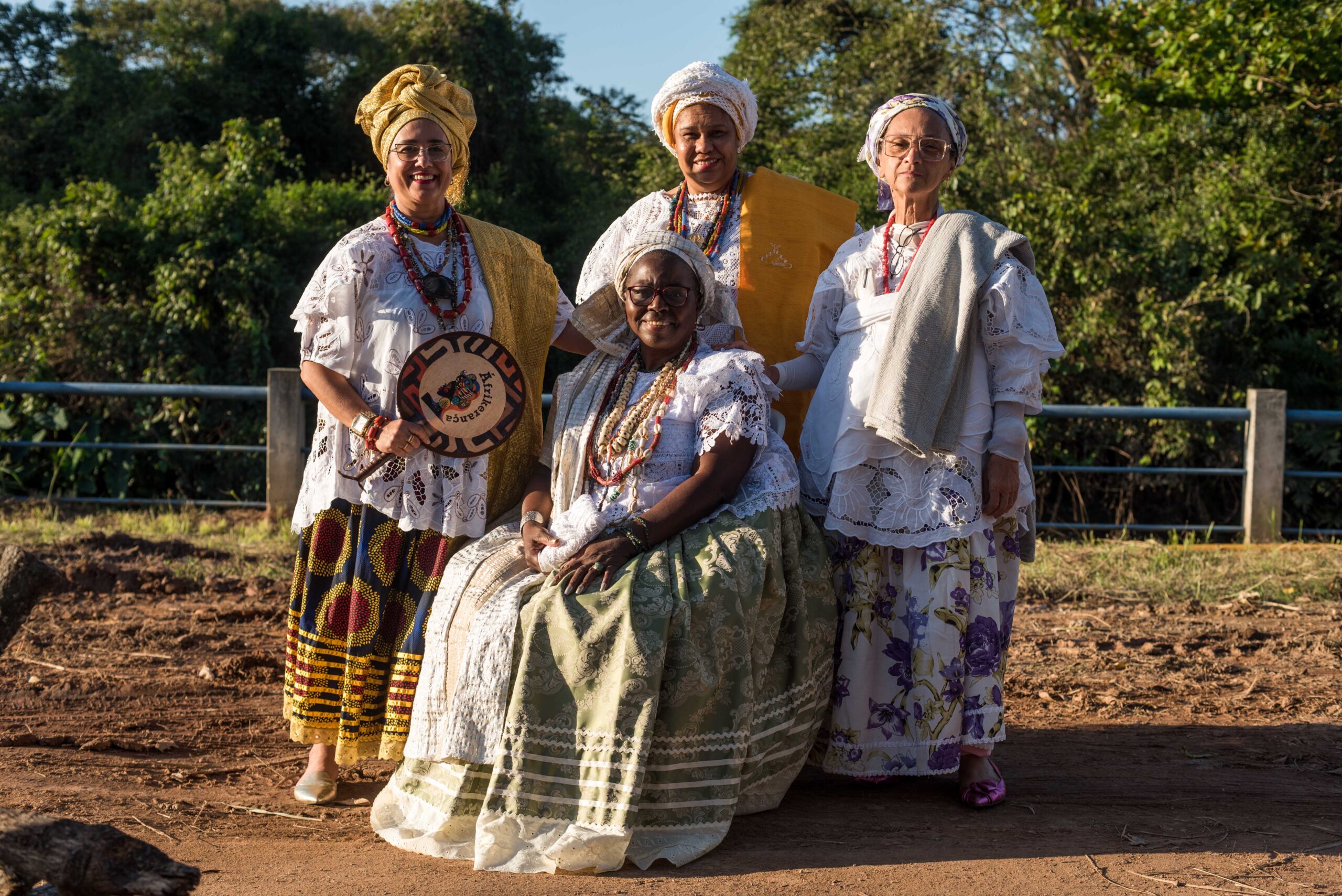
On August 13, the Third Meeting of the Garden of Sacred Herbs was held in Guaratiba, in Rio de Janeiro’s West Zone. The event was organized by Candomblé priestess Heloisa Helena Costa Berto, Iyalorixá [Priestess] Luizinha de Nanã, as she is known in her faith, and her terreiro [place of worship], situated in the same neighborhood. The meeting took place over the whole of Saturday and was marked by strong mobilization by religious and political leaders, supporters, and public institutions. Increasingly driven to transform the street leading to her terreiro and home, Luizinha got the word out and initiated the movement. For practitioners of Afro-Brazilian religions, we are one with nature and everything that surrounds us. And it is through nature that community relations are built—not only religious and spiritual ones but also educational, scientific, and political.

Luizinha is a woman engaged with the very essence of collectivity. For her, everything works best in and for the community. For this reason, in many of her speeches, the matriarch made sure to praise the power of collectivity that made the event possible. Helping amplify her voice, support came from many fronts including local heads of Candomblé and Umbanda temples (traditional Afro-Brazilian religions); influential leaders from organizations in Rio’s West Zone and from other parts of the city such as the West Zone Solidarity Web, Afrikerança, Criola, and Women of Stone; as well as teacher, writer and Candomblé priest Babalorixá Márcio de Jagun. Public agencies such as Comlurb (Rio de Janeiro’s waste management utility), Guaratiba Local Government, Guaratiba Regional Administration, “CRAS do Axé” and councilwoman Teresa Bergher—president of the Commission for Defense and Human Rights in Rio de Janeiro’s City Council—were also present.

“The Terreiro Taught Me Everything!”
The event’s activities aimed to emphasize the importance of Afro-Brazilian culture for building a more tolerant and less racist society. The program included samba group Vozes da Rua, Jongo Eleda, a dance performance in honor of Orisha Nanã performed by ballerina Ana Beatriz Moreira, a space for children organized by Alfazendo (a socio-environmental organization from City of God), as well as a stand by the West Zone Solidarity Web. Throughout the day, the Iyalorixá made sure to underscore the meeting’s purpose, not as a party, but as a political and educational act. The motivation behind this event became urgent to Luizinha after suffering acts of religious racism.

Having been forcibly evicted from Vila Autódromo in the lead-up to the 2016 Rio Olympics, Luizinha lost not only her house but her temple. Some time after relocating to a plot of land facing the Jardim Piaí Channel, in Guaratiba, she felt compelled to redefine and reconstruct both her private space and common areas. And so, she did. In efforts to start the recovery process of the land and polluted waters of the Piaí Channel, Luizinha mobilized many people, institutions, public agencies, and leaders for the event on March 5. Once the land and water had been restored, Luizinha planned to create a garden of sacred herbs for common use in the surrounding area. However, a few days after a task force prepared a layer of organic topsoil for soil recovery, Luizinha de Nanã returned to find the space had been set on fire.

Luizinha analyzes:
“This event serves to assert the fight we initiated regarding religious and environmental racism, which runs very deep in the entire country although people have a very different image of us abroad. People are uninformed of the vastness of Afro-Brazilian culture and, for this reason, do not accept the Candomblé religion. Our religion, and all others of Afro-Brazilian origin, are the most heavily discriminated against because they are black peoples’ religions. The whole burden of prejudice can take people to extremes, such as the fire on the plot of land where we established our project, despite its aim to make improvements to the street, for the community.”

Behind religious racism is a country that still feeds off a colonial and slave-owning heritage in its collective consciousness. For this reason, it is unable to perceive any movement made by the black population as anything but a threat. When such movements do happen, they are soon stopped through legal, economic, social, or educational means, or even physical force. The phrase “religious intolerance” can sometimes sound like a euphemism, as these acts should be called what they really are: religious racism. Data show that in Brazil religious intolerance has a preferred target: black religions.
As stated in the following excerpt from the book Religious Intolerance by teacher, PhD, and Babalorixá [Candomblé priest] Sidnei Nogueira:
“We often hear that it is ‘necessary to tolerate diversity.’ This apparently progressive and well-intentioned expression evokes indignation in some of those being tolerated. No, we don’t need to tolerate anyone. To ‘tolerate’ means something like to ‘indulgently put up with something.’ In other words, to bear with it, to be resigned, even without expressly consenting to such behavior. Those who tolerate do not respect, do not want to understand, do not want to grasp. It is something done with the eyes closed, as an obligation. First and foremost, ‘tolerating’ difference attributes power to those ‘who tolerate’ over those ‘being tolerated,’ as if their very existence depended on the tolerator’s consent.”

According to the National Human Rights Ombudsman (ONDH) from the Ministry of Women, Family and Human Rights (MMFDH), 111 complaints of freedom of belief violations were filed this year between January 1 and March 16 alone. This means that the country officially records, on average, three reports of religious intolerance every two days. In 2021, 581 incidents were reported, with the highest number (138) recorded in the state of Rio. Most of the victims are from communities and religions of African origin, which suggests a racial motivation behind the country’s religious attacks. The violations against freedom of belief are therefore strongly related to race and religious racism.
The black population in Brazil—originally kidnapped from Africa to enrich European colonies—has been resisting oppression for 500 years and keeps its traditions alive through the power of words, collective memory, and the certainty that ancestry and power do not abandon their own. Luizinha is a living example that we still need the strength of oral tradition so that the real history of the African diaspora is not erased.

It is through actions such as Luizinha’s, by a black woman from [the sacred force] Axé, that the black community in Brazil demands reparations for the many layers of structural racism in our society. For years, affirmative action policies have been demanded by important movements, from the quilombos to the Unified Black Movement (MNU), to others that paved the way.
The education of its youth by the community and through nature is a key principle of African philosophy and one of the pillars of religions of African origin. In planting a garden of sacred herbs on the banks of the Piaí Channel, Iyalorixá Luizinha de Nanã simply wished to follow her ancestors and educate her community in caring for a natural good. Teacher, writer and Babalorixá Márcio de Jagun reflected in a similar way at the event:
“Luizinha brings to light very important reflections and actions for the understanding of our diversity. Every time we mention education with (the word) science in its singular form, we ignore other possibilities of the sciences, other possibilities of religions, of education. For example, religions of African origin find sacred inspiration from nature, with the true possibility of divine unfolding in earth, water, fire, and air. And that’s exactly what Luizinha is providing. For other people, not just followers of these religions, to understand the possibility of finding God in leaves, wind, water, earth, and air.”

Education in spaces deemed non-conventional has long been a form of resistance for the black community in Brazil. This is especially true considering the black population has been consistently denied access to educational spaces since the country was founded. Elders taught and spoke of their culture, feasts, ceremonies, and rituals in samba, capoeira and jongo circles and at moments of worship at the terreiros. These are still educational spaces today. This is what Luizinha strives to perpetuate in her terreiro and its surroundings—community and ancestral education through nature.
“Every terreiro is a place of intense politics. A terreiro is a community. A terreiro is a quilombo with educational, behavioral, and social policies. I know this because I was educated by my family during the week and in the terreiros on weekends. So, I too was educated in a terreiro. As an only child, education in the terreiro was very important in my life because it taught me to share, to socialize and respect my elders. That’s why the terreiro is a profoundly political space. It teaches respect for our elders, valuing what we have, caring for what belongs to us and to others. There is the superior role of yalorixá, the mãe de santo [mother of saints who runs the terreiro] as I am. Other roles then follow. And people must respect the elders as well as the young.” — Luizinha de Nanã
The event organizers made a point to set up diverse spaces in which the black community teaches and learns. For this reason, although it felt like a celebration, with samba and jongo circles and food, all these elements served as reminders that education happens in various ways. The regional coordinator of the Afrikerança project, Iyalorixá Marcia Ávila D’Osun, added:
“We place importance in starting a pedagogy of sustainability, to work with the environment, because we are part of it. Not only for the human being inside the Axé [faith], but also for those in the surroundings (of the terreiros). We must remember that we are part of this sustainability, of nature, and that without it, our bodies do not exist, our food does not exist. That, in itself, is Axé pedagogy.”

“We suffer extensive religious racism and the work done by Luizinha is great for the children, teaching them how to plant, and showing other people that our work, our rituals are sacred. Various forms of education exist within Candomblé. Her intervention here, her garden of sacred herbs project is very important for the community,” said Iyálode Ojéwunmi Rosângela D’Yewa, founder of the project of Candomblé matriarchs, Afrikerança.
Everything that happened on this day was a great lesson. An entire community united to show infinite political and educational possibilities, not only through nature, but through body movement, music, food, and oral tradition.
Thank you, Mother Luizinha de Nanã.
About the author: Carla Souza is an educator by training and an early childhood teacher who is passionate about her profession. Raised in Rocinha, she understands her existence as a black, favela woman as a focal point for struggle and resistance in the world.
